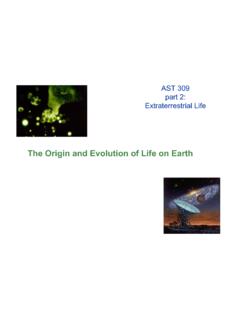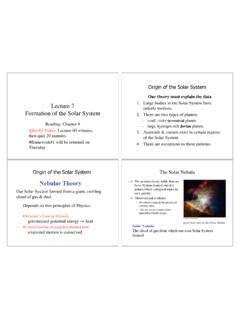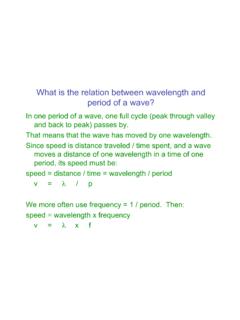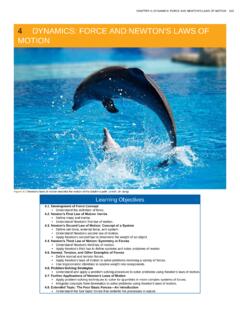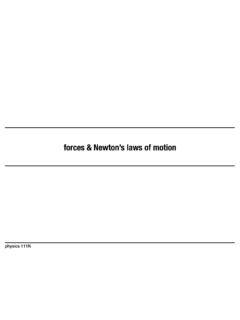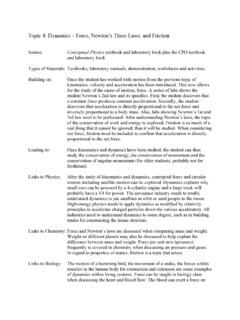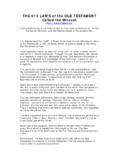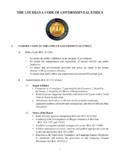Transcription of Newton’s laws of motion and gravity
1 newton s laws of motion and gravity newton s laws of motion1. Every body continues in a state of rest or uniform motion (constantvelocity) in a straight line unless acted on by a force.(A deeper statement of this law is that momentum (mass x velocity) is aconserved quantity in our world, for unknown reasons.)This tendency to keep moving or keep still is called inertia. 2. Acceleration (change in speed or direction) of object is proportional to:applied force F divided by the mass of the object m a = F/m or (more usual) F = maThis law allows you to calculate the motion of an object, if you know theforce acting on it. This is how we calculate the motions of objects in physicsand astronomy. You can see that if you know the mass of something, and the forcethat is acting on it, you can calculate its rate of change of velocity, so you canfind its velocity, and hence position, as a function of To every action, there is an equal and opposite reaction, forces aremutual.
2 A more useful equivalent statement is that interacting objectsexchange momentum through equal and opposite determines the strength of gravity ?The Universal Law of Gravitation ( newton s law of gravity ) mass attracts every other is directly proportional to the product of is inversely proportional to the square of thedistance between their s Law of gravity (cont d):Every object attracts every other object with a force F ( gravity ) = (mass 1) x (mass 2) / R2 (distance squared)Notice this is an inverse square law (right illus.). Orbits of planets (and everything else) are a balancebetween the moving object s tendency to move in a straightline at constant speed ( newton s 1st law) and thegravitational pull of the other object (see below). Now we ll see how all this can be combined to calculatethe motion of any object moving under any force ( gravity orotherwise--like a magnetic force, or friction, or is gravity ?How is this force transmitted instantaneously, at a distance?)
3 ( Gravitons --translation: we don t know).Today, gravity is interpreted as a field that is a property ofspace-time itself, or even stranger really knows what gravity is, we just see things used to this: Physics does not know what anything is or how it reallyworks. Another example: What is light ?Physics is only concerned with developing models that can explainphenomena and newton s laws are important only because they allow us to calculate andpredict things. But no one knows what inertia or gravity really physicists are urging that we remove the word mass from thephysics vocabulary, because it plays no essential role!Using newton s laws , this procedure ( newton s 2nd law with the law of gravity ) you (or atleast someone) can derive Kepler s laws , if you know the form of thegravitational force. For gravity we have newton s formula Fgrav = G m1m2/dwhere G is newton s gravitational constant (you don t have to know it svalue), m1 and m2 are the two masses, and d is their separation (distancefrom each other).
4 From this it can be shown that all closed orbits are ellipses, that the orbitalmotion is faster when the two objects are closer to each other (Kepler s 2ndlaw), and Kepler s 3rd law, the most important s third law now contains a new term: P2 = a3/ (m1+ m2) newton s form of Kepler s 3rd law.(Masses expressed in units of solar masses; period in years, a in AU, asbefore). This is basically what is used (in various forms) to get masses of ALLcosmic objects! Another way to word it: if you know how fast two objectsare orbiting each other, and their separation (notice you need the distanceto get this), you can solve for the sum of their masses. We will use thisover and over--it is the only way we have to get masses most important thing about newton s laws is that they are general: you cancalculate the motion of any object (or any number of objects) acting under anyforce can be calculated, in principle, if the force can be specified ( force as a function of mass and distance; but it could be frictionalforce, magnetic force, electrostatic repulsion.)
5 We calculate the evolution of clusters of stars, of millions of galaxies in anexpanding universe, of a hot gas in a magnetic field, and almost everything else,although in general this is so difficult that you can only get computer shown on next : Earth s orbital period (1 year) and average distance (1 AU) tell us the Sun smass (think: why don t you need to know the Earth s mass for this purpose? Orbital period and distance of a satellite from Earth tell us Earth s mass. Orbital period and distance of a moon of Jupiter tell us Jupiter s mass. This is how black holes were discovered to actually exist (later in course),and how the masses of planets orbiting other stars are determined. motion of stars in galaxies reveals the existence of invisible mass, or darkmatter, whose nature remains unknown. A complex example of the use of newton s laws : Illustration below shows effect ofgravitational forces between two galaxies that are in the early stages of collisional newton s laws for millions of stars and for the gas within these galaxies, we canactually make models for such phenomena that show how tidal forces are distorting thesegalaxies.)
6 This example shows you that some orbits can decay, leading to merging of will see this again when we discuss the cannibalism of planets by their parent of material onorbits under gravity ,Kepler s laws , newton s laws andthe way newton s form of Kepler s third law cangive us the masses of astronomical fact it is just about the only else can you learn about astronomical objects?All you get from them is their light, so there aretwo chapters just on how we can analyze : Properties Properties of Light (ch. 3 in text) This is an extremely important topic, because the only things we can learn about objectsand phenomena outside our solar system are learned by analyzing the light they send us. Ina sense astronomy is all about how to collect, analyze, and interpret light. Can consider light as waves or as particles, depending on circumstance. (One of the bigmysteries of physics.) Either way, it is common practice to call them photons.
7 Light can be thought of as a wave that arises due to an oscillating (vibrating)electromagnetic field (see text). Unlike other kinds of waves, light does not require amaterial medium for its propagation (travel); light can propagate in a vacuum. (Don t worry about polarization in text if it is confusing to you. It won t be on the exam.)Waves: Need to understand and become familiar with the following properties of light (willdiscuss in class):Wavelength Always denoted by Greek letter .Frequency how many waves pass per second, denoted f or Speed All light waves travel at the same speed, the speed of light , c (=3x105km/sec = mi/sec (286,000 miles per second); no need to memorize these numbers! Energy--the energy of a photon is its frequency times its speed E = f x cIt is extremely important that students become familiar and comfortable with these termsand symbols--they will recur throughout the class. See pp.)
8 65-66 of textbook, and illustrationon next wavelength, frequencyImagine pebble dropped in pond: surface waves will appear to travel between peaks ortroughs = wavelengthHow many peaks or troughspass by you per second?= frequency The fact that light travels at a finite speed ( c ) means that we seedistant objects as they were in the our neighbor, the Andromeda galaxy shown in Fig. in your text itis about 2 million light years Later we will look back to times near the beginning of the universe (billionsof years ago) using very distant galaxies. Spectrum: Possibly the most important term to understand in thiscourse! It refers to the mixture of light of different wavelengths from a givensource; best to remember it as a graph of intensity (or brightness) of radiationin each wavelength (or frequency) interval. See illustrations in sec. Willdiscuss in class.(Note: much of rest of class is concerned with analyzing the spectra ofdifferent types of astronomical objects so get used to the concept now.)
9 Light from all objects covers an extremely large range of wavelengths (orfrequencies), from radio waves to gamma rays. Memorize this list, and study and carefully: radio, infrared (IR), visible, ultraviolet (UV), x-rays, gamma raysIt lists the regions of electromagnetic spectrum, the classes of light, fromsmallest frequency (largest wavelength) to largest frequency (smallest wavelength).It also goes from smallest energy to highest restriction of human wavelength sensitivityHuman vision is only sensitive to a very tiny fraction of all this radiation, the visible or optical part of the spectrum astronomy in the last 50 years has beenmostly concerned with getting out of this region. That is probably the single mostimportant technical revolution in astronomy-- for most of this radiation you have tobe above the Earth s atmosphere. Atmospheric absorption and windows Earth s atmosphere is very opaque (light can t get through) except in the visible(also called optical ) and radio parts of the spectrum (the so-called optical andradio windows ).
10 That s why much of recent astronomy is done from p. 70 of textbook on atmospheric opacity and get used to the word opacity. Illustrations of the various wavelength regionsThe illustration (from your text) on the next slide illustrates the differentcategories of light--please note that they are just historical conventions thatare useful. But there is no definite boundary between, say, ultraviolet andx-rays, or infrared and radio. The next illustration is just an alternativepresentation of the same third illustration is worth studying: Earth s atmospheric windows. NOTE:The units of wavelength ( Angstroms, nanometers, microns) andfrequency (Hertz, MHz, GHz) are just something you have to get used to inorder to understand the text and the lectures, but you will not be asked tomanipulate or memorize them on exams. However do not ignore them either,or you ll have much trouble reading the text or understanding electromagnetic spectrum again Atmospheric absorption and windows Earth s atmosphere is very opaque (light can t get through) except in the visible (also called optical ) and radioparts of the spectrum (the so-called optical and radio windows ).

